Debbie Young's Blog, page 15
January 26, 2022
Me & My Mini #2: Amie McCracken
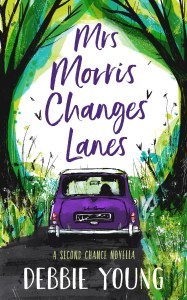 Cover design by Rachel Lawston inspired by the single-track roads of the Cotswolds in spring
Cover design by Rachel Lawston inspired by the single-track roads of the Cotswolds in springAlthough I’ve never owned or even driven a Mini car, it seemed the perfect choice for the heroine of my recently-published novella, Mrs Morris Changes Lanes, in which an unusual loan car takes the heroine on a lifechanging journey.
Even prior to publication, as soon as I shared the wonderful cover design by Rachel Lawston, showing a purple Mini driving down a Cotswold lane, friends began to tell me how much they missed their Mini.
I couldn’t resist finding out more about the reason for their brand loyalty to the iconic little car. I was sure it must be different from Mrs Morris’s. I invited them to share their experience in a new series of guest posts, which began just before Christmas, with historical novelist Anita Davison. (Click here to read it if you missed it.)
My second guest is US author Amie McCracken, currently based in Germany. Like me, Amie enjoys a touch of magical realism. She is an editor, designer and author. Her latest novella is Leaning into the Abyss, set in the US and Mexico, which starts with the startling premise of Rhea’s fiancé falling off a cliff to his death on their wedding day.
The story of Amie and her Mini is less dramatic! Over to Amie to tell us all about it.
Hello, Amie! To start with, please tell us why and when you acquired your first Mini.
On Christmas Day 2013 in fact. I had been on the lookout for one and thought I would fly to the UK since they are cheaper there, but a friend found one near me in Germany that was pristine and I couldn’t pass it up.
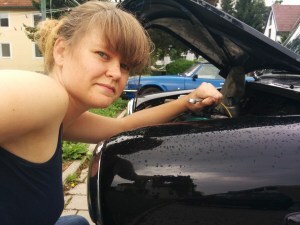
How much did it cost and how much did you sell it for?
I bought it for 4,000 Euro in Germany and sold it in the US for 8,000 dollars.
They were never manufactured in the US, so they are a huge novelty.
And our buyer happened to be Austrian so she could read the German manuals and receipts!
How long did you keep it and why did you sell it?
I sold it in 2017 because it made sense. The plan had been to restore it, completely decked out in TARDIS style (the US plate we had on it said GALIFRY). I had even used it in a video announcement of my pregnancy and brought my son home from the hospital in it.
But we found an interested buyer and I knew it just wouldn’t work to bring the car back to Germany again. It was the right time, though I still miss her.
Please describe it in as much detail as you can remember.
A 1989 Mini Mark IV, none of that BMW crap. It had been repainted, so it was a glistening black. The interior was gray, and the driver’s seat dug into the middle of your back terribly. The heater never worked, so when it rained we had a sponge on the dash to wipe away the condensation. But the car ran when I needed it most. At least, most of the time.
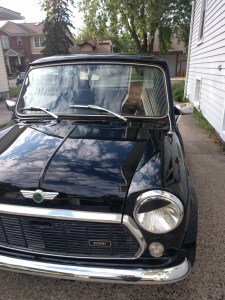
Many Mini drivers seemed to feel compelled to name their Minis, as if they have a personality of their own. (Do they have a personality of their own?!) What was yours called?
Foxy. My plate in Stuttgart was FX 1989.
What is it about Minis that makes most owners feel so attached to them?
I think it comes down to the history.
They are a classic, and most classics come with the history of their entire model.
A Mustang is more than the metal and rubber it is made of, but is the smell of burning tires and speeding down a straight track.
A Mini is an everyday car that putts along with personality and carries a twinge of cheekiness.
I know mine liked to break down at the most inopportune moments, but when I was really in a pinch she stepped up and did the job.
What did you most love about your Mini?
I loved feeling so tiny yet safe. She handled like a Formula 1 car.
What drove you nuts about it?
But without the heater working rainy days and cold days were the absolute worst.
Where did your longest journey in your Mini take you?
The car moved with us across the ocean from Germany to the US.
But the most memorable trip was from Coburg to Berlin to catch a flight, stuck in European summer traffic, with plenty of time to spare and yet still needing to reach speeds beyond the 140 km/h the speedometer could read. We reached the airport with seconds to spare, but as we watched the plane board from the other side of the empty security line, and had the security officer tell us that digital tickets were not accepted, we gave up and got back in the Mini to drive home.
What was your most exciting trip?
See above…
What most surprised you about your Mini?
How well a car seat fit in the back!
Did you ever have any accidents or any scary trips in your Mini?
No. Even when we drove next to American semis and SUVs, I felt safe.
Who was your favourite/most interesting/most difficult passenger and why?
My son on all counts. He was never a fan of riding in the car when he was a baby, so it was always an adventure! Plus, trying to maneuver him into the back seat with a rear-facing infant car seat while he was asleep and without waking him—that was a true challenge. Part of the restoration plans involved adding a third door.
Was your Mini a one-off buy or did you stay brand loyal and buy more Minis later?
I have not bought more Minis, though I believe I will one day. Always the classic versions. Never a BMW.
What car do you drive now?
Now it’s a 1973 VW Type 2 camper! (Also called a Bulli here in Germany.)
What do you miss about your Mini?
The novelty of owning a fun and classic car.
What would be your dream car if money were no object?
A Koenigsegg. Or maybe a Lamborghini Diablo. I like to go fast. Which, admittedly, the Mini does not satisfy.
In Mrs Morris Changes Lanes, what did you think of her Mini and of her adventure?
I loved it. The Mini is certainly a magical car, and the perfect one to bring someone back to their roots. It is a mischievous car, one that I could see yanking a person out of their intended path to create a little bit of chaos and stir things up.
Thank you, Amie, for sharing your fond memories, anecdotes and photos of your beautiful Mini!
Extract from Leaning into the Abyssby Amie McCracken
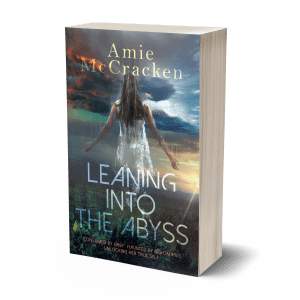 The world was in chaos around me. I sat in the eye of the storm, glass of water growing heavy in my hand, every now and then feeling a kiss on my cheek or the pat of a hand on my shoulder. Dad sat in his own separate world in the far corner, ensconced in his wingback chair, waiting for the rest of us to leave. His house was the closest to the hotel, and the largest, so we had convened here to understand what was going on.
The world was in chaos around me. I sat in the eye of the storm, glass of water growing heavy in my hand, every now and then feeling a kiss on my cheek or the pat of a hand on my shoulder. Dad sat in his own separate world in the far corner, ensconced in his wingback chair, waiting for the rest of us to leave. His house was the closest to the hotel, and the largest, so we had convened here to understand what was going on.
To find out more about Amie and her books and services, please visit her website: www.amiemccracken.com
Have you ever owned or driven a Mini? Amie and I would love to hear about yours!
January 12, 2022
A A Milne – My More Distinguished Twin
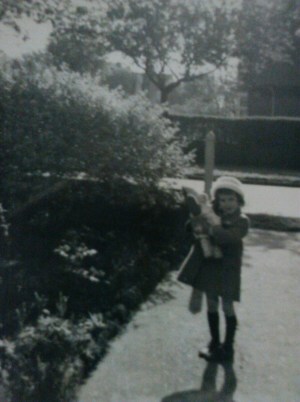 Me, aged about 5, in my front garden with my multi-coloured teddy as my ally of the moment.
Me, aged about 5, in my front garden with my multi-coloured teddy as my ally of the moment.Ever since I was a child, I have wondered what it would be like to have a twin.
As the youngest of three children, with a brother and sister five and six years older than me, I used to crave an ally of my own age to provide a balance of power in our family group.
At one stage, I tried to conjure up an invisible friend as a twin substitute, but I soon dropped her as unconvincing and dull, despite my having a sufficiently vivid imagination to believe that bears would get me if I stepped on cracks in the pavement.
It took me until I was nine to find a suitable alternative: Patricia Lawrence, a girl in my class at primary school. We took our shared birthday as a sign that we should be inseparable best friends, and so we were until at the age of 11 we headed for different secondary schools and drifted apart.
Unless you’re a leap-year baby, finding someone who shares your birthday should not be difficult. There’s a 1 in 365 chance with anyone you meet.
For many years, four people in my immediate family had their birthdays on New Year’s Eve – three related by blood and one by marriage. When my mother, aged nine, was asked what she wanted for her tenth birthday, she replied, “A baby brother”. My grandmother conveniently obliged.
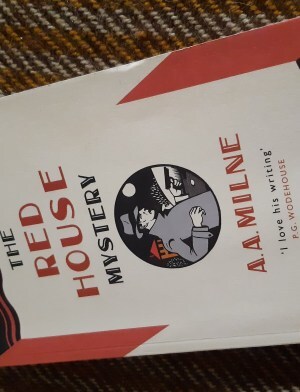 Next on my to-read list: A A Milne’s only mystery novel – endorsed by P G Wodehouse, no less!
Next on my to-read list: A A Milne’s only mystery novel – endorsed by P G Wodehouse, no less!I know a lot of people, yet the only other person I’m aware of who shares my birthday is A A Milne, born in 1882. In tribute to Milne’s most famous creation, our shared birthday is now deemed National Winnie-the-Pooh Day. I wonder what Milne would make of that, when he wrote much more besides the Winnie-the-Pooh stories and poems, including screenplays for the embryonic British film industry, various novels, short stories, and humorous articles for Punch magazine.
Alan Alexander Milne died before I was born, but growing up in a household where Pooh stories were staple bedtime stories, I always felt a certain bond with him.
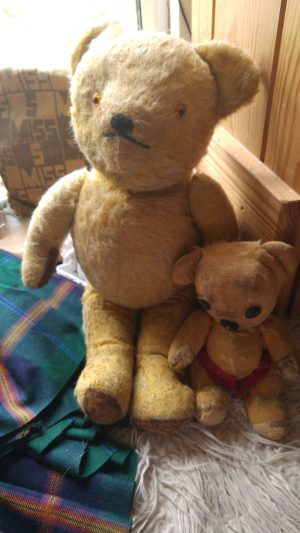 My favourite childhood Teddy (right) with a bigger friend, Galloway, rescued from a charity shop in Dumfries
My favourite childhood Teddy (right) with a bigger friend, Galloway, rescued from a charity shop in DumfriesAnother Milne-related memory from my childhood is my first experience of school drama, when I played the Queen in my infant school’s production of Milne’s poem “The King’s Breakfast”. The King was played by one Malcolm Bothwell, which even then struck me as an impressive name. In later life he’d have been right at home in the cast of Shakespeare’s Macbeth.
Feeling that Milne belonged to my childhood, I’d never considered him in the context of his own time, so I was startled to discover recently that:
(a) he was taught at school by the Victorian author HG Wells
(b) in adulthood he played on cricket teams with J M Barrie, P G Wodehouse, and Sir Arthur Conan Doyle (another author irritated not to gain more recognition for his huge output of fiction besides his most famous creation).
That’s one remove from Christopher Robin, Peter Pan, Sherlock Holmes and Bertie Wooster sharing a social occasion – what an interesting fantasy dinner party guest list they would make.
Meanwhile I’m pleased to be sharing A A Milne’s birthday later this month. If he was still alive, on January 18th, he’d be 140. There’s nothing like being the more junior twin to make one feel younger. Thank you, Mr Milne – and happy birthday to us both!
(This article was first published in the January 2022 issue of the Hawkesbury Parish News.)
NB E H Shepard‘s wonderful original drawings of Winnie-the-Pooh are still in copyright, which is why I’ve shared images of different bears here instead
Who is your more famous twin? I’d love to know!
Another Tale of Twins: Murder by the Book(Sophie Sayers Village Mystery #4)
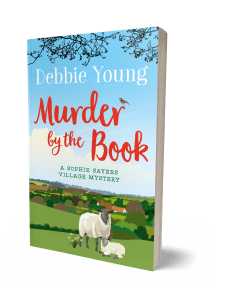 Available in paperback and ebook for Kindle (included in Kindle Unlimited)
Available in paperback and ebook for Kindle (included in Kindle Unlimited)I’d always wanted to write a novel featuring twins, and having established the charming Hector Munro as the heroine’s romantic interest in my Sophie Sayers Village Mystery series, in the fourth installment, Murder by the Book, I couldn’t resist cloning Hector to produce his more mischievous and daring brother Horace.
Unlike the sensible Hector, who has chosen the gentle career of a bookseller in the Cotswold village of Wendlebury Barrow, Horace has ventured overseas, working as an adventure holiday guide in Australia. When he comes home to visit one January, he puts Sophie’s loyalty to the test – and finds out some secrets Hector would rather he didn’t know.
This perfect seasonal read is available in both paperback and ebook for Kindle, and if you are a member of Kindle Unlimited, you’ll have free access to this and all my novels as part of your subscription.
Order your copy of Murder by the Book online here – or place an order for the paperback at your local neighbourhood bookshop. (That would please Hector!)
January 5, 2022
Scenes from my Cotswold Cottage #1: Reading After Breakfast
This is the first post in a new monthly series of blog posts inspired by Dame Joanna Lumley’s charming memoir, No Room for Secrets, in which she tours her London house giving a commentary on her possessions. I’m going to show you snapshots of the Victorian Cotswold cottage in which I write my books, with a commentary on what the objects in each picture mean to me.
My travels may not have taken me as far as Dame Joanna’s, and my friends and relations may not be as famous, but I hope you will enjoy these little insights.
So without more ado, here is the photograph I took this morning of where I like to read for a little while each morning after breakfast – a habit I got into during the first lockdown, when it provided a source of comfort amid so much uncertainty.
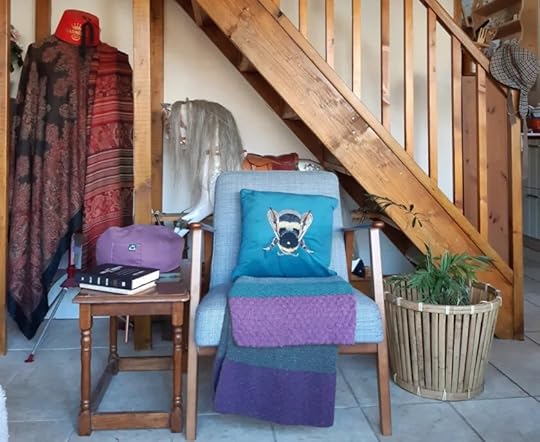
The armchair is in the modern extension that my husband built a few years ago. The old part of our cottage has thick, solid stone walls and small windows, which keep it snug in winter and cool in summer, but they also make it very dark. Previously, we could only see our cottage garden from the utility room and my upstairs study.
The new room was therefore designed to give us a panoramic view of the garden and a space filled with natural daylight. We also wanted a high ceiling, in contrast with the low ones elsewhere in the cottage. The stairs lead to a mezzanine floor, added above the old kitchen to make the most of the height.
During Covid restrictions, this light and spacious room, with its view of the great outdoors, really benefitted our mental health.
Now for a commentary on the details of the photo…
The armchair, facing the French doors, may seem unremarkable, being standard-issue IKEA, but I bought it because its mid-century design reminded me of the green sofa in the lounge of my childhood home in Sidcup, on the edge of London. I was very happy there.The jade-green cushion with embroidered bumblebee, one of my favourite emblems as my name is Hebrew for “bee”, was a Christmas present from my old school friend Jane.The woollen blanket I knitted during the first lockdown, when I discovered “lockdown blankets” were a thing, because they are a great source of comfort during the knitting as well as on completion. I chose shades of the Scottish Highlands in Rowan Felted Tweed pure wool, becaues for the previous 20 years we had spent many holidays in our camper van in Scotland, and I was missing it very much. It was a bonus that my blanket won first prize in the knitting category at Hawkesbury Village Show this year. (Last year’s village show was postponed due to restrictions.)The rocking horse behind the chair was made by my father, hand-carved with love, when my daughter – his only granddaughter – was two years old. She’s now 18, but you’re never too old for a rocking horse made by your grandpa. It will forever be a family heirloom.The little table came from a charity shop, and on it is an iBeani bookrest (the purple beanbag) recommended by my friend Carol Turnham, who belongs to my Cheltenham writers group. It’s really useful if your hands are affected by arthritis, as mine are.The bottom book, Seven Spiritual Laws of Success by Deepak Chopra, was recommended by my writer friend, Michael McMahon.The book above it, The Bullet Journal Method by Ryder Carroll was bought just after Christmas at TK Maxx – a shop I never usually visit, but my sister had recommended it, and sure enough, there waiting for me was a single copy of this book that I’d been meaning to read for a while. I snapped it up, along with half a dozen beautiful notebooks. (Well, a writer can never have too many notebooks.)The dressmaker’s dummy was given to me by my Auntie Sheila, 91, and the Paisley shawls draped over it are from her daughter, my late cousin Frances. Frances loved wool and textiles, and elsewhere we have felt pictures and cloth that she had spun and woven. We think of her every day.The fez is a souvenir of a hugely enjoyable Madness concert at nearby Westonbirt Arboretum.On the end of the banister is a Sherlock Holmes deerstalker hat which I gave to my daughter a few Christmases ago for her Sherlock collection.The basket and parlour palm were acquired from a neighbour during lockdown, when lots of people in our village put unwanted items on their front walls for others to take home. Treasure-hunting like this was a fun diversion when we were living such restricted lives.Out of sight, behind the dressmaker’s dummy, is a wooden goose, made by my husband as an accessory for my scarecrow of St Wulfstan, which I made for the Hawkesbury Scarecrow Trail two years ago. St Wulfstan was formerly the priest of our parish church of St Mary the Virgin , where I sing in the choir and ring the bells. Why the goose? Find out more here. Less interestingly, there’s also a length of copper pipe, left over from some plumbing my husband was doing. I’ve no idea why it’s there or how long it’s been there, and I must find it a more appropriate home!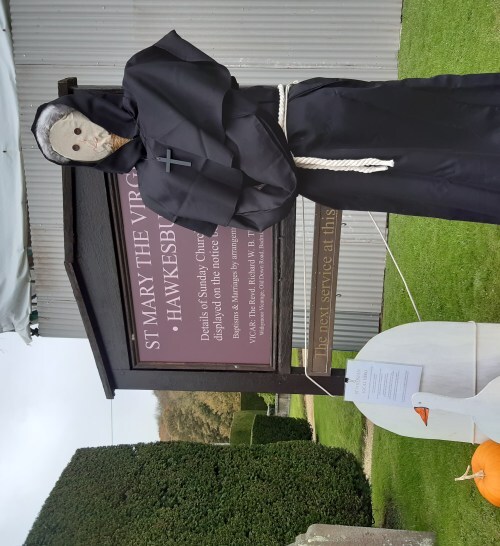 St Wulfstan and his goose
St Wulfstan and his gooseSeasonal Comfort ReadsIt was only in compiling this list of artefacts that I realised the reason I love sitting here so much. It’s not just the view of the garden or the comfy chair, but that I’m surrounded by associations with people and places that I love. Where better for comfort reading?
 Speaking of comfort reads, if you fancy a lighthearted and cheery story set at this time of year, Murder by the Book, a laugh-out-loud village mystery tale of love, friendship, loyalty and family ties.
Speaking of comfort reads, if you fancy a lighthearted and cheery story set at this time of year, Murder by the Book, a laugh-out-loud village mystery tale of love, friendship, loyalty and family ties.
It’s available in paperback and as an ebook for Kindle (also in Kindle Unlimited).
Order Murder by the Book here.
Now I must get back to writing my next book, Scandal at St Bride’s, also set at this time of year. It should be launched in the spring.
Both Murder by the Book and Scandal at St Bride’s culminate on Valentine’s Day – happy ending guaranteed!
In the meantime, I wish you a very happy new year, with lots of great books and comfy reading chairs!
December 29, 2021
Travels with my Book #12: To Iceland with Bjorn Larssen
 Meet Bjørn Larsson, author of “Storytellers” and more
Meet Bjørn Larsson, author of “Storytellers” and moreIn a year when there have been so many constraints on travel, I’ve really enjoyed touring the world through the pages of good books and sharing some of my favourites with you on my blog. I’ve saved for my final post in this series, and of 2021, for an author who blew me away with his vivid debut novel set in Iceland, Storytellers. I’m delighted to welcome Bjørn Larssen – who describes himself as “writer, blacksmith, spiritual Icelander” – to tell us why he is so passionate about that country, and how it has inspired his writing.
Bjørn, welcome! Please would you kick off by describing the location of Storytellers.
I set Storytellers in Klettafjörður, a non-existent village on the Icelandic coast in the south-west. Originally I picked an actual village, but as the story continued to develop I realised its inhabitants might not be happy about it… and I’d like to make more friends there before I start on the enemies.

Please give us a brief description of Storytellers.
In Storytellers, a historical suspense novel set in 1920, Gunnar, a hermit blacksmith, finds an unexpected guest on his farm one night… a guest with a broken ankle and a story to tell, one that might change Gunnar’s life by ending it – once the storyteller recovers enough to write the other characters’ final chapters.

I believe there’s also in the pipeline another, quite different book set in Iceland – what will that book be like?
My work-in-progress, currently called Untitled Romance because I’m very creative like that, will be an m/m sweet-with-heat romance (duh) set in Reykjavík and its surroundings.
The book is not just about the love between the characters, it’s my love letter to Iceland as well.
There is more coming. I’m unlikely to stop writing about Iceland.
What makes Iceland such a great setting for your stories?
I needed a location that could be simultaneously claustrophobic and far away from everything, and I specifically wanted some of the characters to be fishermen. As I was writing the first draft I didn’t have any particular place in mind. At the same time I was listening to Ásgeir’s debut album, Dýrð í dauðaþögn (Glory in the Silence) on a loop and suddenly it occurred to me that Iceland was an actual country. Until then I just sort of imagined it as some mythical spot with a Björk in it.
I bought a book about the relevant period in Icelandic history, Wasteland With Words: A Social History of Iceland by Sigurður Gylfi Magnússon, and it turned out that Iceland had been created especially so that I could set my book there. Although maybe it was the other way round.
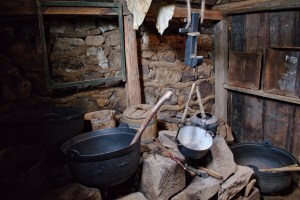 Typical Icelandic kitchen from the 1880s
Typical Icelandic kitchen from the 1880sWhat is your relationship with Iceland and how much of your life have you spent there?
I corresponded with a historian at the Reykjavík City Museum and the Árbæjarsafn open-air museum, who helped me a lot. Still, I had a lot of specific questions and wanted to get a feel for the place, and that open-air museum had buildings from the exact period I was writing about. It was supposed to be a four-day outing with some geysers, waterfalls, or whatever they had there. Instead I fell in love with the strange planet that Iceland is. The year after we went for an entire month, because I was hoping to get over the infatuation. It only got worse.
I intend to live there someday, my heart already does.
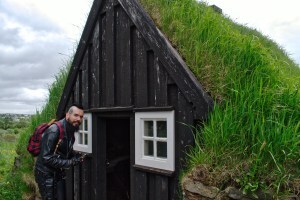
What is special about the people native to Iceland?
In the 19th century Iceland had the highest literacy rate in the world – and most of its inhabitants wrote (they still do) diaries and poems. In Halldór Laxness’ novel, Independent People, farmers who meet for a funeral first discuss deworming their sheep, then read the poems they have written since they’d last met. I thought that was dark comedy. It wasn’t.
Since Laxness won a Nobel prize for literature and Iceland only has 350 thousand inhabitants, that means they have the most Nobel prizes per non-existent million inhabitants, too!
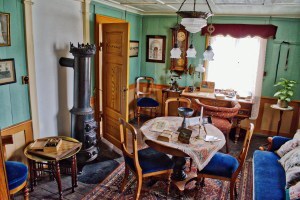 Icelandic sitting room from the 1880s
Icelandic sitting room from the 1880sWhat are your top tips for any readers planning to travel to the setting of your book?
Iceland is one of the most expensive places in the world. The Bónus supermarkets are your friends, but they don’t sell alcohol – no shops do, except for designated liquor stores. If you want to chat over a beer or two either stock up at the airport, or drive to a liquor store, or be prepared to pay one kidney per pint of beer. In the bars you’ll be able to chat with fellow tourists, because Icelanders socialise in the public pools.
For the love of Gods, don’t buy bottled water in a place where the tap water comes straight from the glacier. (That’s cold tap water. The hot water comes from the geothermal springs. You’ll get used to the rotten egg smell, but if you dyed your hair, do not wash it with this water. I found out the hard way.)
 Cold tap water comes from glaciers, while the water in the hot tap comes from thermal springs
Cold tap water comes from glaciers, while the water in the hot tap comes from thermal springsIf you want to see the Northern Lights, go between October and March, in the beginning of April it never gets dark enough anymore. Which means you can go for a drive at 2am and have the normally crowded tourist spots mostly to yourself.
 Heidmork
HeidmorkIcelandic national dishes are (whispers) horrible. Kjötsupa, the meat soup, and the baked goods are exceptions. Ethics aside, you really don’t need to try the shark or the whale, just buy any old rotten fish and dip it in vinegar mixed with salt. Instead, find the hot dog booth near the Saga museum, which is by the way incredibly disappointing – they sell the best hot dogs in the world. Literally. Award-winning. They taste like hot dogs.
And do NOT touch the moss. Just don’t.
“Only in Iceland” – name three things that could only exist/happen there.
There is a dating app that allows you to check how close your relationship with the potential partner is – there are simply very few Icelanders and, well, it’s an island that’s been historically isolated for a very long time.No Icelander is going to say with 100% certainty that elves DEFINITELY do not exist.If you meet one, an elf, not an Icelander, don’t eat any food they give you. Say thank you, then dispose of it when the elf can’t see you any more.Are there any other books set in Iceland that you’d like to recommend?
Halldór Laxness, obviously. I haven’t read Ragnar Jónasson’s books, because thriller is not my genre of choice, but I hear he’d murdered half of the country by now and did so rather interestingly. I still need to get to Burial Rites by Hannah Kent. And you can’t go wrong with Alda Sigmundsdóttir’s Little Book of Icelanders series, although those are technically non-fiction.
Where is your latest book set and where will the next one be set?
Children, a dark-but-funny re-telling of selected Norse myths, is set in the heathen Nine Worlds – and its sequel, Land, will add the tenth world, Earth. Land will be a re-telling of Hrafnaflóki’s discovery of Iceland, but with more Gods, magic… and the Hidden Folk, of course.
EXTRACT FROMStorytellers by Bjørn Larssen
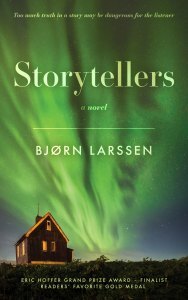 Available in ebook, paperback and hardback
Available in ebook, paperback and hardback“Sshh,” Arnar whispered. “Put on your coat and come outside.”
Where are we going, Juana wondered, half-asleep as she crawled through the small door. The cold night air roused her within seconds. It was cool inside the hut, but outside it was freezing, everything covered in a thin layer of ice, lit by moonlight, and, and…
“Look at the sky,” he whispered. Juana obediently raised her eyes, and her mind went blank as her mouth opened in shock.
Something that resembled green fire danced in the sky. The colours moved faster, then slower. They disappeared, then reappeared, regrouping stronger, covering the stars. Their shine was so powerful that the frozen grass appeared greener than during the day, a gleaming colour she had never seen before.
“There,” Arnar pointed, and Juana’s eyes followed. The flames painted the sky, slowing down, stopping as if teasing, then returning to their dance with renewed energy.
“Is this magic?” she whispered. “Is it mountains changing shape? Is the sky burning?”
“When the nights get longer and darker, this is what God sends us to let us know he hasn’t forgotten about us,” he whispered back. “It seems dark, aye, but there is light and always will be. When you think things are going bad, remember they will always turn out fine. This is what þetta reddast means. It will always turn out fine.”
Juana shivered from the cold, but she didn’t care, fascinated by the magical lights. If there was a pattern to their dance, she couldn’t understand it. The green colour was now being licked by a hint of purple, as if the flames themselves were set on fire again. But the fire she had known until now never looked or felt like this, it never obscured the stars or cast a greenish glow. “Are you sure this isn’t dark magic?” she whispered and made a sign of the cross.
“This is the fire that burned in my heart every day that I spent in America,” said Arnar, holding her hands tight and kissing her cheek. Juana didn’t pay him much attention, staring, trying to understand the impossible. Only God or Devil could create something like this, and the beauty convinced her it was God himself. He was giving them their blessing. “This is what happiness looks like,” whispered Arnar, and she believed him.
ORDER YOUR COPY OF STORYTELLERS HERE
(available in paperback, hardback, ebook and audio from a wide range of stores)
FIND OUT MORE ABOUT BJØRN LARSSON HEREBlog – Facebook – TwitterPREVIOUS POSTS IN THIS SERIES:To Fiji with B M AllsoppTo the Caribbean with Helen HollickTo Europe and Roma Nova with Alison MortonTo Egypt with Carol CooperTo The Fair Land with Lucienne BoyceAround the world with Clare FlynnTo Italy with Jean BurnettTo Salzburg, Austria with JJ MarshTo the Aland Islands in the Baltic Sea with Helena HalmeTo Wales with Jean GillTo Birmingham with A A AbbottPREVIEW OF MY NEW GUEST POST SERIES FOR 2022
My guest post series for 2022 will address travel from a completely different angle.
Under the series heading “Me and My Mini”, a diverse range of authors will share their passion for their Mini cars, past and present – a car that started to fascinate me when I was writing my new novella, Mrs Morris Changes Lanes, earlier this year.
Posts in this series will appear on the last Wednesday of each calendar month. Click here to read a test-drive I took with this idea a couple of months ago, when historical novelist Anita Davison took us for a spin.
In the meantime, if you haven’t already read Mrs Morris Changes Lanes, now would be a good time to try it! Order the paperback from your local bookshop quoting ISBN 978-1911223818 or online here, or download the Kindle ebook here. (If you’re a Kindle Unlimited subscriber, you’ll be able to read the book for free!)
And if you have already read and enjoyed it, reviews are always welcome!
In the meantime, wishing you a very happy, healthy and peaceful 2022.
December 24, 2021
My Christmas Gift to my Readers: A New Sophie Sayers Christmas Story
Each Christmas for the last three years, I have enjoyed taking part in Helen Hollick’s “Story Song” blog series, which is a bit like an advent calendar of stories.
Every day between 1st and 24th December, she posts a new story by a different author. Each story is inspired by a song, and readers are invited to guess the song by reading the story. You can read all of the stories on her blog completely free of charge.
This year, my contribution is a new Sophie Sayers short story set at Christmas, called The Secret Ministry of Frost.
It also features some characters from my St Bride’s School novel series.
Click the link below to read this heartwarming new story for free:
Read The Secret Ministry of Frost online now
Will you be able to guess the song by the end of the story?Award yourself a bonus point if you have already recognised the poem that the title comes from!***Please feel free to share the link to the story with anyone who might enjoy it.***
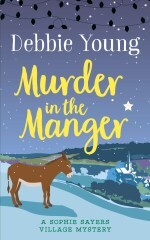 The third novel in the Sophie Sayers Village Mysteries series is set at Christmas
The third novel in the Sophie Sayers Village Mysteries series is set at ChristmasAlthough my Sophie Sayers Village Mysteries series includes a novel set at Christmas (Murder in the Manger), the cosy world of Sophie’s Cotswold village, Wendlebury Barrow, is a rich source of festive stories, and I plan to write enough to fill a little book with them in time for Christmas 2022. More news on that nearer the time!
In the meantime, I wish you a merry Christmas, with lots of good books under your Christmas tree, and a new year filled with peace, joy and love.
December 23, 2021
The Museum of You
Each year, as soon as the clocks go back, I begin to look forward to the fresh start a new year will bring. A pessimist might say that if I haven’t yet mastered time management, financial planning or decluttering, a new year is unlikely to make a critical difference. But I’m an incurable optimist, and in the last few weeks, chance sayings by three people of my acquaintance have inspired me for the year ahead.
Catching up with an older friend after a couple of years apart, I was taken aback when she declared, “I reckon I’ve got another eight good years ahead.” From a less exuberant, busy type, that might have sounded like self-pity, but she was filled with gratitude. Never mind carpe diem, she plans to seize the next 2922 days and squeeze every drop of life out of them.Trying to reach an elderly gentleman by phone, I was tickled by his answerphone’s announcement: “I’m busy having fun right now but leave a message and I’ll get back to you.” He’s right: fun is not the preserve of the young. Focusing on fun for however many days remain to you is a sound philosophy.The third arresting statement came from a much younger friend: “I’m proud of the life I’ve curated for myself.” Curated? I thought. What is she, a museum? Then I realised it was the perfect shorthand for purposeful management of your life. Like a good museum, she takes regular stock of her assets, jettisoning any that are irrelevant or surplus to her personal mission. A good museum doesn’t stash away its best possessions for fear of breakage or loss – it exploits them with gusto.Curating a Life of Fun and GratitudeWhen I went on a writers’ retreat last month, it came up in conversation how sad it is when someone dies leaving gifts or purchases unopened, having saved them for a special occasion that never happened.
My writer friends and I vowed that when we got home, we’d crack open all those fancy notebooks no writer can resist buying but often cannot bear to sully.
By the same token, in my kitchen, I moved to the top of the drawer all the pretty unused tea towels previously nestling beneath the much-laundered, greying, and holey ones in constant use.
In my bedroom, I rejected snagged tights that I’d been eking out to the point of decomposition and ripped the wrapper off a beautiful, patterned pair I’d bought about three years ago, even though I had no plans to go out that day.
My daughter, with the natural assurance of the teenager, has a theory that the older you get, the more you are pleased by small things.
 (Photo by Gabrielle Henderson on Unsplash)
(Photo by Gabrielle Henderson on Unsplash)Given the pleasure I’ve just gained from a fresh notebook, a virgin tea towel, and brand-new tights, I can hardly disagree. But I’m also reassured that whatever the new year brings after the stress of a post-Brexit pandemic year, it won’t take much in 2022 to make me happy.
I wish you a contented and peaceful Christmas, and a new year of living your best life.
(This post was originally written for the December 2021/January 2022 issue of the award-winning Tetbury Advertiser.)
Recommended Reading on the Theme of Fresh StartsIn three of my stories, the main characters are seeking fresh starts for a happier life:
 A novella of fresh starts and second chancesSophie Sayers when she moves to the Cotswold village of Wendlebury Barrow in
Best Murder in Show
, first in the Sophie Sayers Village Mysteries seriesGemma Lamb as she starts a new job at St Bride’s School for Girls in
Secrets at St Bride’s
the first in the Staffroom at St Bride’s seriesJuliet Morris when she accepts the loan of a car with extraordinary powers in
Mrs Morris Changes Lanes
, my stand-alone novella
A novella of fresh starts and second chancesSophie Sayers when she moves to the Cotswold village of Wendlebury Barrow in
Best Murder in Show
, first in the Sophie Sayers Village Mysteries seriesGemma Lamb as she starts a new job at St Bride’s School for Girls in
Secrets at St Bride’s
the first in the Staffroom at St Bride’s seriesJuliet Morris when she accepts the loan of a car with extraordinary powers in
Mrs Morris Changes Lanes
, my stand-alone novellaIf you haven’t already read them, why not give one a try?
December 15, 2021
O, Flower of Christmas!
When I was a child growing up in a London suburb, one of the highlights of our festive season was to sing carols around the huge Christmas tree in Trafalgar Square.
Although this may sound like a very English tradition, the Trafalgar Square Christmas tree is not British at all, on two counts.
Firstly, Christmas trees only caught on in Britain after Prince Albert introduced the concept from his German homeland in 1848. You may be surprised to realise that the quintessential portrait of the Victorian British Christmas, Charles Dickens’ A Christmas Carol, published in 1843, does not contain a single Christmas tree.Secondly, the tree in Trafalgar Square is a gift from the people of Norway. They have sent one every year since 1947 to thank Britain for its support during the Second World War. (An interesting aside: the word “quisling”, meaning traitor, derives from the name of Norwegian Nazi collaborator Vidkun Quisling, who from 1942 until 1945 led the German-friendly government while the King of Norway took shelter in Britain.)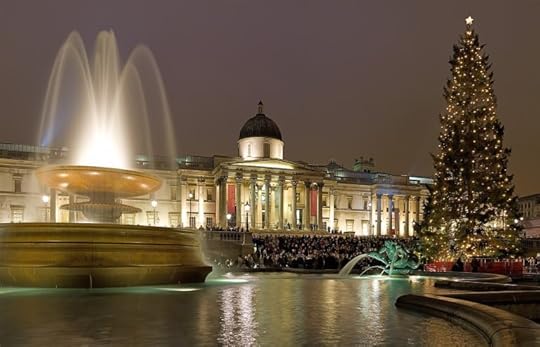 By Diliff – Own work, CC BY-SA 3.0, https://commons.wikimedia.org/w/index.php?curid=1488315
By Diliff – Own work, CC BY-SA 3.0, https://commons.wikimedia.org/w/index.php?curid=1488315Evergreens of other kinds, such as holly, ivy, and mistletoe, have been part of a British Christmas for centuries. Borrowed from pagan winter festivals, they symbolise the promise of new life, whether in the form of spring or the birth of Christ.
The poinsettia, however, is a relative newcomer to the traditional Christmas canon of plants. Until recently, I’d assumed the only reason it pops up in shops in December is because of its festive colours. Not so.
The connection comes from a sweet Mexican legend…
 By André Karwath aka Aka – Own work, CC BY-SA 2.5, https://commons.wikimedia.org/w/index.php?curid=16584
By André Karwath aka Aka – Own work, CC BY-SA 2.5, https://commons.wikimedia.org/w/index.php?curid=16584A little Mexican girl was fretting because she was too poor to buy a birthday gift for Jesus, to lay at her local church’s manger scene, in keeping with village tradition. Suddenly an angel appeared, telling her to gather weeds from the roadside, because what mattered was not the cost of her gift, but what was in her heart. Her neighbours were scornful when she brought a bouquet of green weeds to the church, but in a heart-warming Christmas miracle, as she set them down on the altar, red flowers sprang up among the green leaves in the shape of the star of Bethlehem.
My first slightly frivolous thought on hearing the story was that it’s a Mexican take on my favourite carol, “In the Bleak Midwinter”: “What can I give him, poor as I am? I know, I’ll bring a poinsettia.”
As you probably know, the red parts of the poinsettia technically aren’t flowers at all, but leaves that have turned red. Its flowers are the tiny yellow buds at the centre of each cluster of red leaves. But modern botanical definitions don’t detract from the power of the legend.
While the name we use for the plant commemorates the American diplomat, Sir Joel Roberts Poinsett, who first imported cuttings from Mexico to the US in 1836, in Mexico, it’s known as flor de Navidad (Christmas flower) and flor de Nochebuena (flower of the Holy Night). The closest the Mexicans have to a Christmas tree is a decorated cactus.
Whatever greenery you choose to decorate your home this Christmas, I wish you joy and peace this festive season, and a New Year full of new life and hope.
This article first appeared in the Hawkesbury Parish News, December 2021
Further Festive ReadingWhether you are still Christmas shopping or you would some lighthearted and uplifting books to read during the holidays, you might like to take a look at these seasonal reads.
I’ve provided buying links in case you’d like to order them, but if you have any problems placing orders online, just let me know and I’ll arrange to send them to you myself.
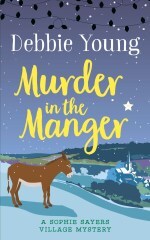
Murder in the Manger – the third Sophie Sayers Village Mystery, a gentle, feel-good story that kicks off when the nativity play penned by Sophie goes somewhat off-script…
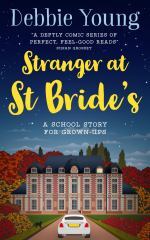
Stranger at St Bride’s As the staff and girls at St Bride’s prepare for their annual Christmas Fair, stranger turns up to lay claim to the estate, and the fight to save the school is on!
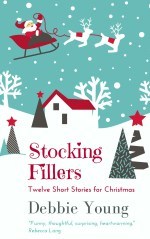
Stocking Fillers – the antidote to pre-Christmas stress, 12 funny stories about different aspects of the festive season, easy quick reads that make the perfect Secret Santa present or indeed a gift to self!
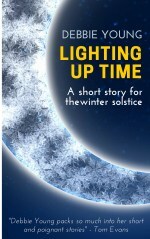
Lighting Up Time – this short story is set at the winter solstice, available in a slim paperback the size of a picture postcard
November 24, 2021
Travels with my Book #11: To Birmingham with A A Abbott
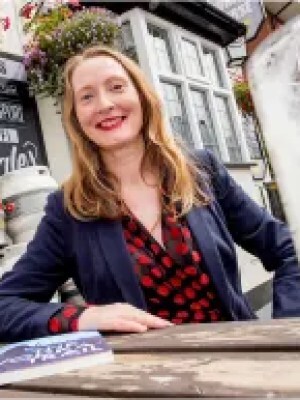 A A Abbott at the White Horse pub, which features in “The Vodka Trail”
A A Abbott at the White Horse pub, which features in “The Vodka Trail”For the penultimate post in my Travels with my Book series of guest authors, I’m delighted to welcome my good friend A A Abbott, who is so enthusiastic about her chosen destination of Birmingham, England that I reckon they should recruit her for the city’s tourist board!
The Birmingham in her books is the British one, in the West Midlands of England – not to be confused with Birmingham, Michigan or Birmingham, Alabama!
London and Bristol also feature in her stories, but Birmingham holds a very special place in her heart. Over to A A Abbott to explain why…
Birmingham is a big city with many suburbs too. Which particular part of Birmingham do you most like to write about?
Its attractive Victorian Jewellery Quarter and the creative Digbeth area.
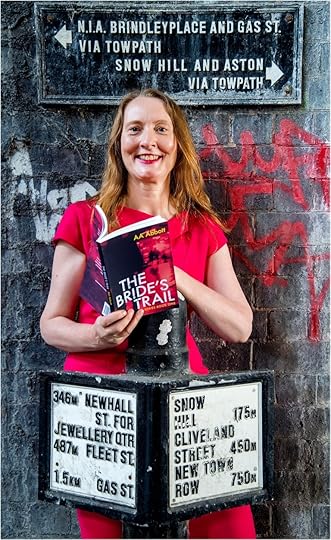 A A Abbott with her first in her Trail series, in the Jewellery Quarter
A A Abbott with her first in her Trail series, in the Jewellery QuarterPlease tell us a little about your latest book to be set in Birmingham.
My psychological thriller Bright Lies is about a teenage girl plunged into a nightmarish situation. She runs away and ends up homeless in Digbeth, because that’s where her one-way coach ticket takes her. It’s also a place with a thriving club scene, which proves to be her salvation.
Bright Lies is my darkest story ever. I’ve also written a mystery thriller series about a glamorous young woman determined to make the world’s best vodka. If only she hadn’t tangled with gangsters when she was down on her luck…
These fun, fast stories feature Birmingham too. There are five books: The Bride’s Trail, The Vodka Trail, The Grass Trail, The Revenge Trail and The Final Trail. Each reads well as a standalone story, but together, they’re a gripping riches to rags to riches saga.
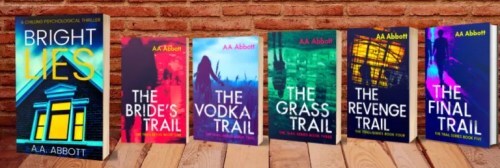 The complete A A Abbott collection
The complete A A Abbott collectionWhat makes Birmingham such a great setting for your stories?
Ever heard the saying that Birmingham has more canals than Venice?
It’s a city of contrasts: fascinating, friendly and fun. You’ll find canal-side cocktail bars, concrete towers and craftsmen making jewellery in Victorian workshops. There’s also an amazing sense of possibilities. The city is infused with a can-do attitude, so it’s the ideal place someone to turn their lives around. In Bright Lies, teenage Emily hits rock bottom and she needs to change in order to survive.
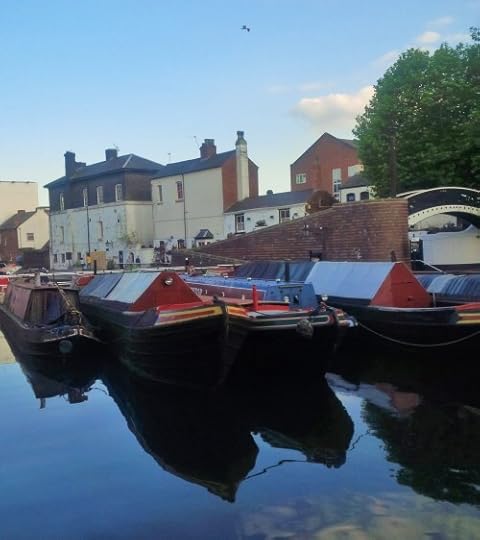 Canal boats at Gas Street Basin
Canal boats at Gas Street BasinWhat is your relationship with Birmingham and how much of your life have you spent there?
I came to Birmingham as a student, adored the city and lived there for two decades. In Brum, as locals like to call it, I met the love of my life (we are still together), became a mum and forged a career. I also went to writing classes run by Barbara Joan Eyre. She wrote Mills & Boon romances to keep the wolf from the door, but darker stories were her guilty pleasure.
What is special about the people native to Birmingham?
You’re never alone in Birmingham. Brummies are the friendliest people you could meet, and strangers are welcomed. Perhaps that’s why, famously, the city is a melting-pot of cultures.
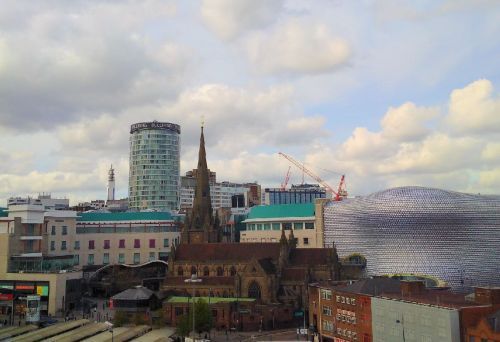 A fascinating mix of old and modern architecture
A fascinating mix of old and modern architectureWhat challenges does your protagonist in Bright Lies face dealing with the local people?
Apart from the Brummie accent, there are dialect words to learn. Emily gets a cash-in-hand job at a nightclub called The Bobowlers. It is some weeks before she discovers that ‘bobowler’ is the local word for a moth. (As you probably guessed, Bright Lies is set just before the pandemic, in times when cash was more widely used.)
What are the distinguishing features of Birmingham in terms of geography, geology, flora, fauna or any other detail you care to mention?!
The city has an exciting mixture of architecture, with ornate Victorian red brick buildings as well as cutting-edge newbuilds like the Library of Birmingham.
My favourite time of year is the autumn, when mellow sunlight really makes the red bricks glow.
 Birmingham’s famous Bull Ring
Birmingham’s famous Bull RingWhat are your top tips for any readers planning to travel to Birmingham?
Take time to explore the canals in the city centre, as Emily does in Bright Lies. See the colourful houseboats and upscale bars in Brindleyplace, then walk to the Jewellery Quarter and grab a coffee in lovely St Paul’s Square. You will see a slower pace of life than the frenetic buzz around New Street station. Also, if you like a beer, you will be pleasantly surprised by the prices. I especially recommend The Gunmakers Arms, which is the brewery tap for Two Towers Ales (named in homage to Brummie JRR Tolkien).
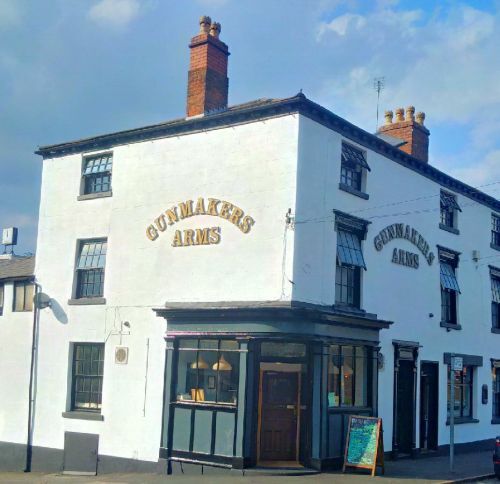 The iconic Gunmakers Arms
The iconic Gunmakers Arms“Only in Birmingham” – name three things that could only exist/happen there.
If you’re female and even remotely young, you’ll be called ‘Bab’. My other half tells me it happens to guys too…You’ll find a library with its own herb garden (the Library of Birmingham).You can walk across a canal bridge decorated with pictures of Black Sabbath. Yes, the infamous rock band hails from Brum!Are there any other authors’ books with the same setting that you’d like to recommend?
There are too many to mention them all, so here are a few! Park Life by Katharine D’Souza is a book all women over the age of forty should read. It’s set in the trendy Moseley and Kings Heath area, where I used to live.
Also, try Tom Bryson’s gritty police procedural stories and Andy Conway’s Touchstone series of time travel tales.
Where will your next book be set?
In a departure from the norm, my next book will be a psychological thriller set wholly in Bristol, where I stayed during the pandemic. Of course, I missed Birmingham. I’m excited to be able to return!
What formats are your books available in?
Bright Lies is available in audiobook, ebook, Kindle Unlimited, paperback, large print paperback and dyslexia-friendly paperback.
(All photos by A A Abbott)
EXTRACT FROM
BRIGHT LIES by A A Abbott
Jack wanders through the dark, silent streets. He stops, stares at the vodka bottle, sets it down and picks it up again. While desiring oblivion, he’s afraid of what might happen first.
He walks away from the city centre, finding himself outside a telecoms shop on Deritend High Street. The decorative red brick terrace was built when the English Midlands were the workshop of the world. Now it’s crumbling at the edges. A shabby black-painted door leads to the flats above. He is supposed to view one with Emily tomorrow, or should that be later today? It’s already Friday morning, although it will be several hours before the sun wheezes over the winter horizon. Until then, frost sparkles orange in the streetlights.
He won’t rent that flat. Without Emily, he can stay in a cheaper, smaller place. A studio is sufficient for his needs. He tells himself he doesn’t care what Emily does. It’s a lie. He cares about Emily a great deal.
At last, Jack unscrews the cap and takes a swig. The neat spirit burns his throat. He hadn’t expected that. Spluttering, he tries again, hoping to be rendered senseless and slumped in a gutter.
It hasn’t worked yet. He still feels stone-cold sober.
Can he believe a word she’s told him? He wants to, but most likely, she’s exactly what she first appeared to be. When they met, he was convinced she was a kid with a coke habit, on the run from dealers. Addicts are polished liars: they have to be.
His phone rings. Jack removes it from his pocket, sees it’s a call from Cassie, and swipes the red button. Who cares what she wants right now? He doesn’t need the hassle.
A moth beats its wings against the lit screen. Jack blows gently at it, sending it tumbling away on the cold air, and replaces the phone in his pocket. The club is well-named, for bobowlers are creatures of the night, seeking light and excitement. Emily has always reminded him of one: fragile, yet a survivor.
To find out more about A A Abbott and her excellent thrillers, visit her website:
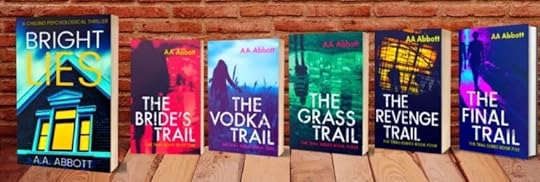
PREVIOUS POSTS IN THIS SERIES:
To Fiji with B M AllsoppTo the Caribbean with Helen HollickTo Europe and Roma Nova with Alison MortonTo Egypt with Carol CooperTo The Fair Land with Lucienne BoyceAround the world with Clare FlynnTo Italy with Jean BurnettTo Salzburg, Austria with JJ MarshTo the Aland Islands in the Baltic Sea with Helena HalmeTo Wales with Jean GillNovember 22, 2021
The Meaning of Kindness
In the run-up to World Kindness Day (13th November), I fell to wondering exactly what the word “kindness” means – not in behavioural terms, but regarding its etymology.
The dictionary reveals that the noun “kindness” is related to kin, as in family (kith and kin) or race (mankind). As an adjective, it originally meant “with the feeling of relatives for each other” – all very well provided your family members had a high regard for each other. Not until the fourteenth century did “kindness” begin to be used more in the modern sense: “courtesy or noble deeds”, with “noble” indicating selflessness rather than a posh pedigree.
Fast forward to the twenty-first century, and scientists can prove that when we are kind to others, our brains release feel-good hormones such as dopamine, oxytocin and serotonin, bringing us physical and mental health benefits.
My grandma used to tell me “Virtue is its own reward”, but so, it seems, is kindness. Thus being kind to others is also an act of self-care – and a great way to make yourself feel better that is entirely free of calories and alcohol units.
The Random Acts of Kindness Foundation, created in 1995, promotes the idea of spontaneous generous gestures to strangers, such as leaving money behind the till of a coffee shop for the next homeless customer or letting someone go in front of you in a supermarket queue. Many such acts are done anonymously.
The phrase “anonymous benefactor” always makes me think of Magwitch in Charles Dickens’ Great Expectations, although most nameless donors will have only anonymity in common with Pip’s ex-convict associate.
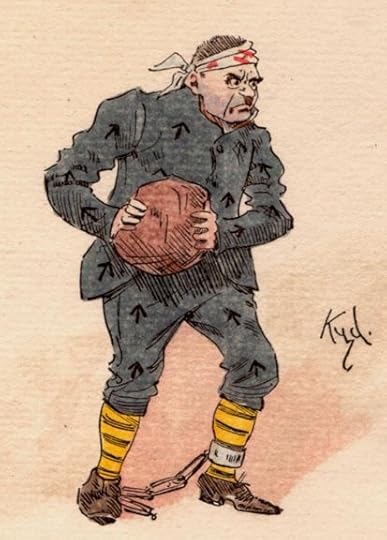 Plot spoiler alert: Magwitch is Pip’s anonymous benefactor in Charles Dickens’ Great Expectations. Illustration by J Clayton Clarke (Kyd), public domain.
Plot spoiler alert: Magwitch is Pip’s anonymous benefactor in Charles Dickens’ Great Expectations. Illustration by J Clayton Clarke (Kyd), public domain.
When making online donations I always hesitate before clicking the “show my name on the website” box in case it looks like virtue-signalling. I also wonder whether offering this option is just smart psychology on the part of fundraising sites. Do donors who make their name visible feel obliged to give more money than those who hide their identity? I’d love to know.
Now here’s an easy way to commit an act of kindness that will not only lift your spirits but include a reward in, er, kind: order a copy of Everyday Kindness, a new anthology of 55 short stories on the theme of kindness, each by a different author, one of whom is me. The anthology, launched on World Kindness Day, is the brainchild of its editor, bestselling novelist and philanthropist L J Ross. All the authors have donated their stories for free, and all profits will go to Shelter, the charity for the homeless and those in poor housing. The hardback and ebook may be ordered online via this link: linktr.ee/EverydayKindness, or you can order your copy from your favourite bookshop.
There, I feel better for that!
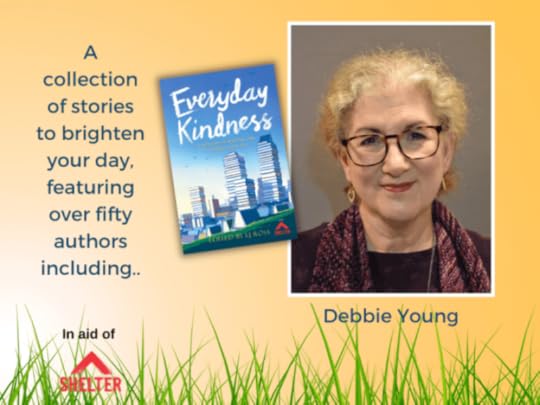 Click the image to order your copy now
Click the image to order your copy nowThis post was originally published in the November issue of the Tetbury Advertiser
November 16, 2021
In the Name of Kindness
A post to mark the launch of the new anthology, Everyday Kindness
When I was a little girl, the idea that your name suggested the kind of person you become seemed part of the natural order of things. Noddy was so-called because he nodded his head a lot, making the bell on his blue cap jingle, and Big Ears – well, you can work that one out for yourself.
To my amusement, I’ve just discovered that the name of this phenomenon, nominative determinism, was coined in 1994 by the magazine New Scientist after it had noticed certain researchers had appropriate names, such as Daniel Snowman, author of a book on polar exploration, and the duo Splatt and Weedon, who wrote a report about urology.
However, the name that has most resonated with me over the years is one I encountered in a primary school assembly, when our headmaster, Mr Bowering, introduced us to one Mrs Doasyouwouldbedoneby. In Charles Kingsley’s The Water Babies, along with her counterpart Mrs Bedonebyasyoudid, she teaches the value of kindness to young Tom, after he has been transformed by drowning into a Water Baby. (My, those Victorian children’s stories were harsh.)
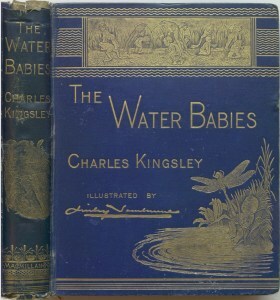 By Thomas Fisher Rare Book Library, UofT – The Water-Babies: A Fairy Tale for a Land-Baby, CC BY 2.0, https://commons.wikimedia.org/w/index.php?curid=54361262
By Thomas Fisher Rare Book Library, UofT – The Water-Babies: A Fairy Tale for a Land-Baby, CC BY 2.0, https://commons.wikimedia.org/w/index.php?curid=54361262Lifelong I have borne her name in mind as a shorthand for kindness, and a secular, catchier equivalent of that bit from the Sermon on the Mount: “All things whatsoever ye would that men should do to you, do ye even so to them.” But until I looked her up the other day, I’d misremembered her as a character from John Bunyan’s A Pilgrim’s Progress, another of Mr Bowering’s favourites, in which the central character, Christian, undertakes a journey to the Celestial City guided by Evangelist, despite protests from grumpy neighbour Obstinate and accompanied by the flaky Pliable.
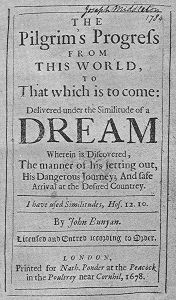 Title page of A Pilgrim’s Progress, 1678 (Public domain)
Title page of A Pilgrim’s Progress, 1678 (Public domain)I was considering reacquainting myself with her by rereading the novel when I spotted reviews that in classic BBC style warn “it contains attitudes of its time” – as if the central premise of sending the children to watery graves wasn’t warning enough. But in the month that features World Kindness Day (13th November), I’d like to pay tribute to Mrs Doasyouwouldbedoneby’s principles and to her creator Charles Kingsley.
As a child, I wondered about the origin of such names.
Did Obstinate’s parents name him because he was a very stubborn baby? Did Noddy enter this world with an exceptionally weak neck, even by the standard of newborns? Did Big Ears’ poor mother require a Caesarean?
Of course, as I grew up, I realised all those characters, unlike the New Scientist’s researchers, are fictitious and their names are simply artistic devices. Even so, I wonder whether I missed a trick when naming my daughter Laura, when I could have chosen a virtue – Faith, Hope or Charity – or even plumped for Lottery Winner Young.
FOR WORLD KINDNESS DAY
World Kindness Day also saw the launch of Everyday Kindness, a new anthology of short stories on the theme of kindness, devised and edited by bestselling mystery writer L J Ross. The stories are written by 55 different authors, one of which is me. My story is Christmas Ginger, the Sophie Sayers prequel, about her Great Auntie May, spending a lonely Christmas in Wendlebury Barrow until an act of kindness by a villager transforms her festive season. This is the first time story has been published in book form.
All profits will go to Shelter, the charity for the homeless and those in poor housing. The book is available online in hardback and ebook via this link: https://linktr.ee/EverydayKindness, or you can order it from your favourite high street bookshop. A great Christmas present or an uplifting gift to self!
 Click the image to order your copy now
Click the image to order your copy nowThis post was originally written for the November issue of the Hawkesbury Parish News



